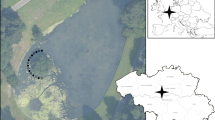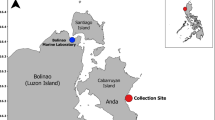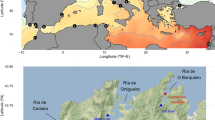Abstract
Reproductive allocation, the proportion of total dry weight allocated to receptacle tissue and reproductive effort, the proportion of reproductive carbon requirement contributed by receptacle photosynthesis, were measured in two fucoid algal species Fucus serratus and Himanthalia elongata at sites in NE Scotland. Reproductive development takes over ten months in H. elongata, a semelparous (single reproductive event) species, and reproductive allocation at receptacle maturity is over 98%. Following gamete release, the whole thallus dies. In contrast, reproductive development in F. serratus takes four months. Fucus serratus is iteroparous (capable of multiple reproductive events), reproductive allocation is 38.6% for the first reproductive event and 50.5% for the following year's event. In Fucus serratus, the receptacles appear to make a major contribution to their own carbon requirements after the first month of reproductive development. The receptacles of Himanthalia elongata contribute only a small proportion of the receptacle carbon requirements in the first four months of reproductive development, after which the contribution made through receptacle photosynthesis increases.
Similar content being viewed by others
References
Åberg, P., 1990. Population ecology of Ascophyllum nodosum: demography and reproductive effort in stochastic environments. Ph.D dissertation, University of Goteborg.
Ang, P. O., 1992. Cost of reproduction in Fucus distichus. Mar. Ecol. Prog. Ser. 89: 25–35.
Back, S., J. C. Collins &G. Russell, 1991. Aspects of the reproductive biology of Fucus vesiculosus from the coast of S.W. Finland. Ophelia 34: 129–141.
Bazzaz, F. A., R. W. Carlson & J. L. Harper, 1979. Contribution to reproductive effort by photosynthesis of flowers and fruits. Nature 279: 554–555.
Brenchley, J. L., J. A. Raven & A. M. Johnston, 1994. A comparison of the growth rate and oxygen exchange characteristics of non-fertile and fertile Himanthalia elongata during reproductive development. The Mycologist 37: 18.
Cody, M. L., 1966. A general theory of clutch size. Evolution 20: 174–184.
Cousens, R., 1986. Quantitative reproduction and reproductive effort by stands of the brown alga Ascophyllum nodosum (L.) Le Jolis in South-eastern Canada. Estuar. coast. Shelf. Sci. 22: 495–507.
De Wreede, R. E. & T. Klinger, 1988. Reproductive strategies in algae. In J. Lovett-Doust & L. Lovett-Doust (eds), Plant reproductive ecology: patterns and strategies. Oxford University Press, New York: 267–284.
Ford, H., F. G. Hardy & R. G. J. Edyvean, 1983. Population biology of the crustose red alga Lithophyllum incrustans Phil. Three populations on the east coast of Britain. Biol. J. linn. Soc. 19: 211–229.
Gibb, D. C., 1937. Observations on Himanthalia lorea (L.) Lyngb. J. linn. Soc. Bot. 51: 11–21.
Gillanders, B. M. & M. T. Brown, 1994. Seasonal variation in standing crop, reproduction and population structure of Xiphophora gladiata (Phaeophyceae: Fucales). Bot. mar. 37: 35–41.
Harper, J. L., 1977. Population biology of plants. Academic Press, London: xxiv + 892 pp.
Klinger, T., 1985. Allocation of blade surface area to meiospore production in annual and perennial representatives of the genus Laminaria. M.Sc. thesis, University of British Columbia, Vancouver, 96 pp.
Knight, M. & M. Parke, 1950. A biological study of Fucus vesiculosus L. and Fucus serratus L. J. mar. biol. Assoc. U.K. 29: 439–514.
Lewis, J. R., 1964. The ecology of rocky shores. English Universities Press, London: xii + 323 pp.
Lüning, K., 1990. Seaweeds: their environment, biogeography and ecophysiology. John Wiley & Sons, Inc, New York, xiii + 527 pp.
Mathieson, A. C. & Z. Guo, 1992. Patterns of fucoid reproductive biomass allocation. Br. phycol. J. 27: 271–292.
Mathieson, A. C., J. W. Shipman, J. R. O'Shea & R. C. Hasevlat, 1976. Seasonal growth and reproduction of estuarine fucoid algae in New England. J. exp. mar. Biol. Ecol. 25: 273–284.
McCourt, R. M., 1985. Reproductive biomass allocation in three Sargassum species. Oecologia 67: 113–117.
Niemeck, R. A. & A. C. Mathieson, 1976. An ecological study of Fucus spiralis L. J. exp. mar. Biol. Ecol. 24: 33–48.
Pavel, E. W. & T. M. De Jong, 1994. Estimating the photosynthetic contribution of developing peach (Prunes persica) fruits to their growth and maintenance carbohydrate requirements. Physiologia Plantarum 88: 331–338.
Pfister, C. A., 1992. Costs of reproduction in an intertidal kelp: patterns of allocation and life history consequences. Ecology 73: 1586–1596.
Raven, J. A., 1993. The roles of the Chantransia phase of Lemanea (Lemaneaceae, Batrachospermales, Rhodophyta) and of the ‘mushroom’ phase of Himanthalia (Himanthaliaceae, Fucales, Phaeophyta). Bot. J. Scotland 46: 477–485.
Reed, D. C., 1987. Factors affecting the production of sporophylls in the giant kelp Macrocystis pyrifera (L.) C.Ag. J. exp. mar. Biol. Ecol. 113: 61–69.
Reekie, E. G. & E A. Bazzaz, 1987a. Reproductive effort in plants. 1. Carbon allocation to reproduction. Am. Nat. 129: 876–896.
Reekie, E. G. & F. A. Bazzaz, 1987b. Reproductive effort in plants. 2. Does carbon reflect the allocation of other resources. Am. Nat. 129: 897–919.
Robertson, B. L., 1987. Reproductive ecology and canopy structure of Fucus spiralis L. Bot. mar. 30: 475–482.
Samson, D. A. & K. S. Werk, 1986. Size dependent effects in the analysis of reproductive effort in plants. Am. Nat. 127: 667–680.
Stearns, S. C., 1976. Life history tactics: a review of the ideas. Quart. Rev. Biol. 51: 3–47.
Williams, G. C., 1966. Adaptation and natural selection: a critique of some current evolutionary thought. Princeton, Univ. Press, Princeton, N.J., 307 pp.
Author information
Authors and Affiliations
Rights and permissions
About this article
Cite this article
Brenchley, J.L., Raven, J.A. & Johnston, A.M. A comparison of reproductive allocation and reproductive effort between semelparous and iteroparous fucoids (Fucales, Phaeophyta). Hydrobiologia 326, 185–190 (1996). https://doi.org/10.1007/BF00047805
Issue Date:
DOI: https://doi.org/10.1007/BF00047805




